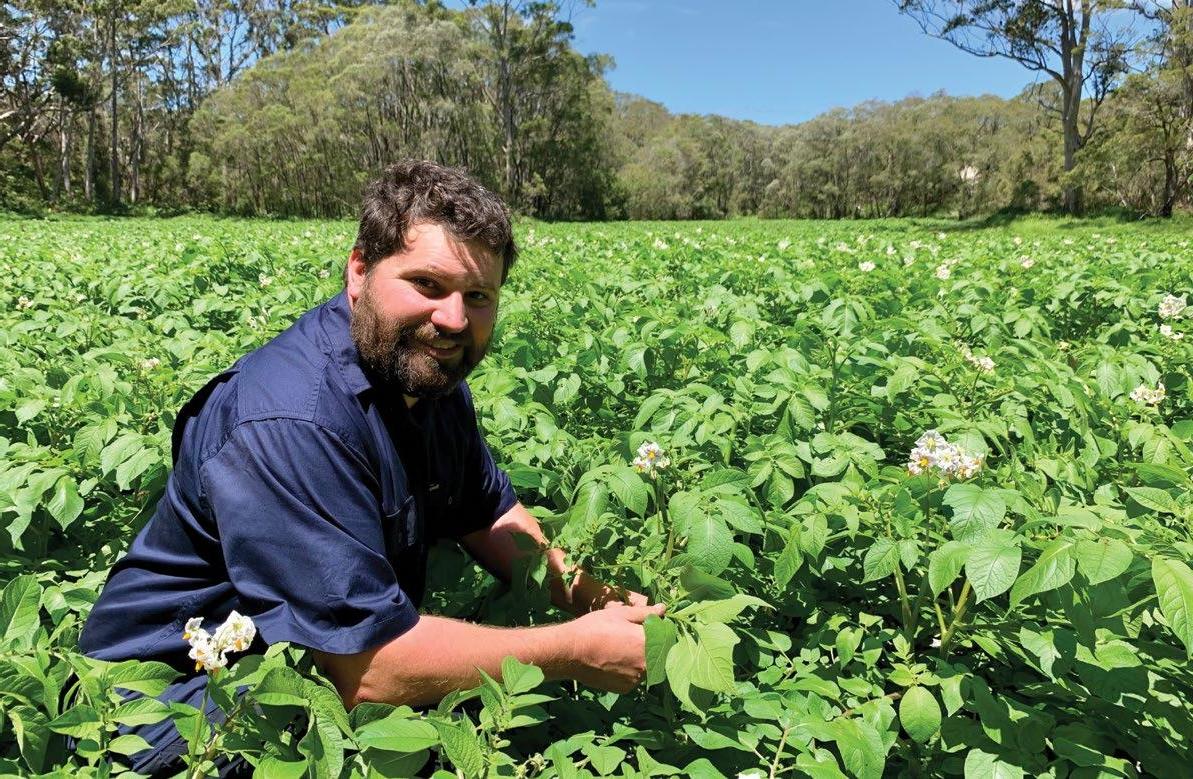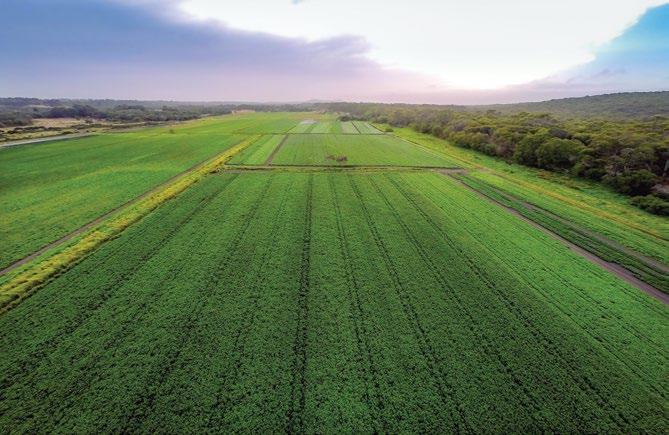
8 minute read
Grower profile: Julian Ackley
Get to know your growers
Julian Ackley
Advertisement
Potato seed growing specialists the Ackleys along with their neighbours, the Westcotts, are proudly continuing the legacy that their forebears put into motion in the 1940s.
PERTH
ALBANY
Farmer Julian Ackley
Location Cuthbert-Elleker, Albany Enterprises Seed potatoes
Located in the Cuthbert-Elleker swamp Q & A areas in Albany, the operation initially grew spuds for the potato board, eventually growing processing potatoes Q How long has your family been in the region? for Edgell, then later seed potatoes for In the early 40s my grandfather Bob the processing industries, and finally Ackley and his brothers came to Albany branching into seed potatoes for the during the war to dig potatoes, which was fresh market as well. in those days by fork. Consequently, in the seed industry. the late 40s my grandfather Bob Ackley During winter, the swamps purchased a swamp in Cuthbert flood and go under water, area (about seven kilometres which eliminates any crop remnants from the previous season. Crops are then grown in the narrow dry window between December and Crops are grown in the narrow, dry window between December and April without irrigation. from Albany) and began potato farming. Forward to 1967, my father Terry Ackley leased the swamp from my grandfather and started April without irrigation. growing potatoes for the Growing quality seed is a highly to buy his own swamp in Cuthbert, skilled process — from variety selection which we still farm today. Around 1974 to the micro-managing up to 30 varieties a school friend of my father, Chris and different growth stages prior to Westcott, purchased a neighbouring being ready to sell. Julian provides more swamp and a long-standing partnership background in the Q&A to his farm and was formed. board. By 1972 he was able
In 2010, Chris Westcott started growing seed potatoes with his son Steven Westcott on the Elleker swamps and I joined my Father farming at the Cuthbert swamp. In 2018, I purchased another swamp in Elleker, next door to Westcotts, and today we both continue the legacy our parents have created for us.
Q What do you enjoy about ‘seed’ potato farming? There are many aspects to being a seed potato farmer that is a bit different — firstly, my customers are almost all farmers. I specialise mostly in the West Australian market and operate across the fresh and processing industries, while also supporting farmer’s market growers, and supplying seed into the nursery industry. Growing seed potatoes is a long process, from ordering mini tuber stock from the laboratories to having a product in my customers’ hands is a five-to-six-year process and there is no return as a seed grower till the end of that process. Ordering the laboratory-grown diseasefree tuber stock starts 18 months prior to delivery. Once we receive that seed, it is planted as a Generation 0 crop. When that seed is grown out, we have a generation one stock, that is then cool stored till the following year and replanted. The potatoes harvested from that crop becomes generation two and again is returned to cool store for the following season. At generation three the seed is virus tested, and then is either sent out for trials if it is a new variety, or is it kept for final bulk out the following year. Once we reach generation four, the seed is finally sold to the commercial grower to
3 CUTHBERT-ELLEKER swamp during summer. 3 CUTHBERT-ELLEKER swamp during winter.

PHOTOS © SKYPRINTS be grown out for market. By this point it has been over five years since the tuber stock was ordered from the laboratory. If the process of ordering the tuber stock was not complicated enough, add in plant breeders bringing new varieties every year. Each of which is a necessary gamble also brings challenges in terms of growing a multitude of different varieties. Some potato varieties reach maturity in as little as 60 days, where others can take as long as 150 days, and this presents complications when trying to micromanage up to four generations of over 30 varieties in a single season. Each variety has its own special requirements and properly understanding that can take many seasons to master. While I will admit, like many farmers, I quite like driving a tractor, working with the plant breeders and eventually turning the varieties they have into commercial success for my customers is the greatest reward.

Q Which is your favourite potato variety to eat? As a seed grower there is no question I am spoilt for choice. When it comes to a waxy variety (for potato salad, boiling or in the slow cooker) Prince of Orange has the waxiness rivalling Kipfler that holds it together even if you overcook it. It has more flavour and a gentle sweetness that really brings it up to a whole another level. It has an agreeable texture and the natural ability to absorb the cooking flavours, in my opinion at least, it is king. Prince of Orange offers all the advantages of a Kipfler, but with none of the drawbacks, and let me add, you can mash it virtually solo, no need for garnish.
A semi waxy for pork roasts or basic vegetable oil roasting, a family favourite in the old variety Norland. It is slightly floury so it crisps up really well near the end of cooking, but is waxy enough to retain some serious flavour.
With lamb roasts or a classic mash, I’ll probably grab a Rodeo or Delaware, but a Prince of Orange works here too. For the floury varieties, when the deep fryer comes out, I’m old school. For chips I am partial to Atlantic, although I’ll consider a Mac russet if its handy too.
For the all-rounder, my father will swear alliance to a Delaware, for me, just like each variety is different to grow, each one excels in a different way in the kitchen, so rather than “it’ll do” I’ll just reach for the right spud for the job at hand.
Q Is there anything about potato farming that you wish consumers knew or understood better? For me it is the fact that it is one of the healthier carbohydrates. I often meet people who will not eat spuds because they swore themselves off the carbs, yet with health benefits in mind are happy to bend the rules for a pasta or rice dish, but not a potato-based meal. Within the industry there are varieties that are wildly different to each other in terms of cooking quality, flavour and texture, yet most consumers have little concept of that fact. Part of that is that the immense quantity of varieties available in WA, which means that they are generally lumped into white, yellow, red and blue. In reality, the colour of the potato has almost no bearing on what the particular cooking quality is. In Western Australia I think this speaks volumes about the success of Royal Blue here, because it has for the most part only been just the one variety. As a result, the cooking quality has remained similar each time consumers bought a Royal Blue branded potato.
Q Look into your crystal ball — where do you hope to see the WA potato industry in five years? As an industry we have really suffered a blow from every possible direction in the last five years, from the end of the potato marketing corporation, the closure of the Smith’s chips factory, the Tomato potato psyllid being detected in WA with the associated export bans, and then finally COVID-19. Our industry has really taken the rollercoaster that doesn’t seem to end. This has meant that as many as half of our growers have left the industry and those remaining have been riding the coaster of dramatically fluctuating prices, severe over supply followed by dramatic under supply which has then led to an increase in imports competing in our own market. Moving forward, we need to leverage what we have in WA; our isolation leads us to a solid position for exporting seed potatoes and we have an excellent record for achieving ultra-low levels of disease, which is important in an international market that often struggles to obtain good quality diseasefree seed stock. I’d like to see West Australian restaurants and retailers increase support of our local potato processors for chips and peeling stock. We have plenty of unused capacity that could be further leveraged to supply a local product grown in WA for West Australians. We may need to increase marketing around WA processed potato products to further boost consumer awareness that these products do exist and the benefits that they offer our state. In the fresh market I hope to see improved stability. To recover some certainty as well as promote better forward planning. As a seed grower, it is exceedingly difficult to forecast what spuds will be on the shelves seven years in advance. When I order my tuber stock from the laboratory that is exactly what I am trying to do. Today’s fresh market potato growers are often uncertain of what to do just a few months in advance. This leads to inability to obtain the right seed and not being able to react and supply to the market’s requirements successfully. There is a significant risk we will lose our own market share to imports if we are no longer able to make plans for the future of our own industry.

3 WHEN it comes to a waxy variety Prince of Orange has the waxiness rivalling Kipfler that holds it together even if you overcook it.










